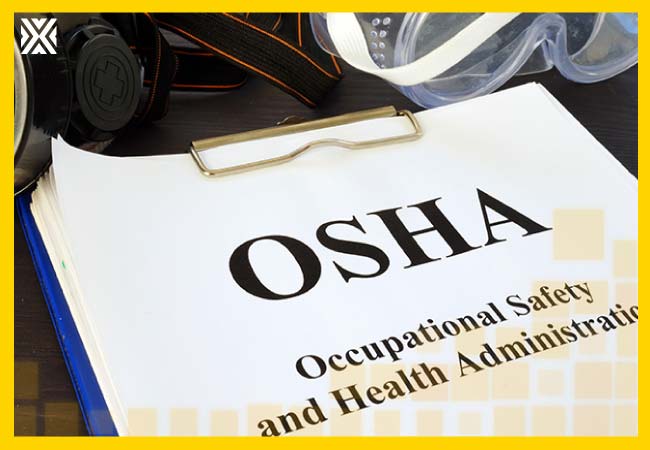Currency
December 13, 2020

Even the most safety-conscious companies sometimes have workers that get injured or sick on the job.
Like many non-exempt businesses with 11 or more employees, you’re keeping an Occupational Safety and Health Act-required record of serious work-related injuries (requiring more than first aid) and illnesses via OSHA’s Form 300 — the Log of Work-Related Injuries and Illnesses.
You have seven calendar days to record an injury or illness after receiving word that a recordable incident occurred.
In general, it’s the employer’s call whether an injury or illness is work-related. But if the work environment significantly aggravates an employee’s pre-existing illness or injury, it counts as work-related and should be logged.

For several reasons — including tracking any emergent hazards and developing standards — OSHA monitors occupational injury and illness data across the nation through a no-fault lens so employers are encouraged to record injuries and illnesses truthfully. In other words, simply logging a workplace injury doesn’t automatically mean a citable safety violation or affect workers’ comp eligibility.
If you’re in an OSHA State Plan state, it’s a good idea to check if there are additional recording requirements or exemptions that apply to your company.
A 2019 OSHA Final Rule removed the requirement to electronically file Form 300 each year for establishments with 250+ employees that are already required to routinely keep injury and illness records. But keep in mind the rule to maintain and hold onto these forms for five years still applies. Logs should be reviewed at the end of the year, corrected if necessary, and signed by a company executive.
The OSHA 300A form — the Summary of Work-Related Injuries and Illnesses — must be filed electronically each year by employers with worksites of 250 or more employees and employers with worksites of 20-249 employees in high-hazard industries (check the North American Industry Classification System number on your insurance documents), such as:
● agriculture
● auto parts
● building supplies
● construction
● delivery services
● dry cleaning and laundry services
● fishing
● forestry
● freight and transport
● furniture, home furnishing and department stores
● grocery stores
● hospitals and nursing homes
● lawn and garden equipment and supplies
● manufacturing
● utilities
● warehousing and storage, and
● waste collection, treatment and disposal
A complete list of high-hazard industries can be found here.
The days are over when the only public place your annual injury and illness summary was posted was in an employee common area. The Center for Investigative Reporting and the Public Citizen Foundation successfully challenged OSHA’s stance in court that Form 300A data is confidential and would interfere with enforcement if made available to the public.
As a result, the agency has posted Form 300A data for 2016, 2017 and 2018 online. It’s downloadable in a spreadsheet form that’s searchable by company name and location. Public Citizen shared the OSHA webpage link on its site as well.
Previously withheld information that’s now publicly accessible in more than one place online includes company number of deaths, Days Away From Work cases, Days Job Transfer or Restriction cases, and totals for skin disorders, respiratory conditions, poisonings and hearing loss.
The records stop short of getting into specific numbers of certain injuries (e.g., amputations), illnesses (e.g., tuberculosis, silicosis, lead poisoning, COVID-19) or how a company’s injury numbers compare to their industry’s average.
Occupational health and safety attorney Adele Abrams said in a Premier Learning Solutions webinar that accuracy in Form 300 and 300A recordkeeping is crucial — especially with work-related injury and illness details that employees, prospective employees, competitors, and local, county and state government officials can now see online.
She noted that falsifying OSHA log data carries criminal penalties harsher than violations linked to an employee fatality and log omissions can become expensive willful violations.
At the same time, great care should be taken in describing incidents related to any serious workplace injury on Form 300A because admissions of violations in the log can be admissible in court. Also, recording “occupational illness” can lead to unwanted liability, unless the employer can demonstrate no over-exposure to toxic substances in its workplace.
In addition, employers are responsible for training employees on their right to report work-related injury or illness without fear of retaliation and having a “reasonable” reporting procedure in place. Not doing so is a violation. This obligation can be satisfied by posting the OSHA “Job Safety and Health – It’s the Law” poster.
Some incentive programs (employees lose an award based on injury) or disciplinary programs (employees are penalized due to injury) violate OSHA retaliation protection guidelines. So now may be a good time to make a compliance review of these programs.
Speaking of disciplinary programs, post-incident drug testing can have a negative impact on employee willingness to report injuries. OSHA policy clarifies that drug testing is permissible if it’s:
● unrelated to reporting of work-related injury or illness
● required by state workers’ comp law
● required under federal law (e.g., DOT), or
● to evaluate the root cause of an incident that harmed, or could have harmed, employees. In this instance, all workers whose conduct could’ve contributed to the incident must be tested.
Regarding contract workers not on the payroll, if they don’t have a crew chief and your company supervises them on a day-to-day basis, any of their work-related injuries or illnesses must be recorded.
You don’t have to log injuries or illnesses if an employee:
● is in the workplace as a member of public
● is engaged in a voluntary fitness program at work
● gets into a motor vehicle accident in your parking lot or while commuting
● has a cold, flu, etc. that’s not a work-related contagious disease
● has a mental illness undiagnosed by a trained healthcare professional
● gets sick from food they brought in from an outside source
● is engaged in personal tasks during working hours, or
● is self-medicating or intentionally injuring themselves.
Like many non-exempt businesses with 11 or more employees, you’re keeping an Occupational Safety and Health Act-required record of serious work-related injuries (requiring more than first aid) and illnesses via OSHA’s Form 300 — the Log of Work-Related Injuries and Illnesses.
You have seven calendar days to record an injury or illness after receiving word that a recordable incident occurred.
In general, it’s the employer’s call whether an injury or illness is work-related. But if the work environment significantly aggravates an employee’s pre-existing illness or injury, it counts as work-related and should be logged.

For several reasons — including tracking any emergent hazards and developing standards — OSHA monitors occupational injury and illness data across the nation through a no-fault lens so employers are encouraged to record injuries and illnesses truthfully. In other words, simply logging a workplace injury doesn’t automatically mean a citable safety violation or affect workers’ comp eligibility.
If you’re in an OSHA State Plan state, it’s a good idea to check if there are additional recording requirements or exemptions that apply to your company.
A 2019 OSHA Final Rule removed the requirement to electronically file Form 300 each year for establishments with 250+ employees that are already required to routinely keep injury and illness records. But keep in mind the rule to maintain and hold onto these forms for five years still applies. Logs should be reviewed at the end of the year, corrected if necessary, and signed by a company executive.
Form 300A
The OSHA 300A form — the Summary of Work-Related Injuries and Illnesses — must be filed electronically each year by employers with worksites of 250 or more employees and employers with worksites of 20-249 employees in high-hazard industries (check the North American Industry Classification System number on your insurance documents), such as:
● agriculture
● auto parts
● building supplies
● construction
● delivery services
● dry cleaning and laundry services
● fishing
● forestry
● freight and transport
● furniture, home furnishing and department stores
● grocery stores
● hospitals and nursing homes
● lawn and garden equipment and supplies
● manufacturing
● utilities
● warehousing and storage, and
● waste collection, treatment and disposal
A complete list of high-hazard industries can be found here.
Public record
The days are over when the only public place your annual injury and illness summary was posted was in an employee common area. The Center for Investigative Reporting and the Public Citizen Foundation successfully challenged OSHA’s stance in court that Form 300A data is confidential and would interfere with enforcement if made available to the public.
As a result, the agency has posted Form 300A data for 2016, 2017 and 2018 online. It’s downloadable in a spreadsheet form that’s searchable by company name and location. Public Citizen shared the OSHA webpage link on its site as well.
Previously withheld information that’s now publicly accessible in more than one place online includes company number of deaths, Days Away From Work cases, Days Job Transfer or Restriction cases, and totals for skin disorders, respiratory conditions, poisonings and hearing loss.
The records stop short of getting into specific numbers of certain injuries (e.g., amputations), illnesses (e.g., tuberculosis, silicosis, lead poisoning, COVID-19) or how a company’s injury numbers compare to their industry’s average.
Avoiding legal issues
Occupational health and safety attorney Adele Abrams said in a Premier Learning Solutions webinar that accuracy in Form 300 and 300A recordkeeping is crucial — especially with work-related injury and illness details that employees, prospective employees, competitors, and local, county and state government officials can now see online.
She noted that falsifying OSHA log data carries criminal penalties harsher than violations linked to an employee fatality and log omissions can become expensive willful violations.
At the same time, great care should be taken in describing incidents related to any serious workplace injury on Form 300A because admissions of violations in the log can be admissible in court. Also, recording “occupational illness” can lead to unwanted liability, unless the employer can demonstrate no over-exposure to toxic substances in its workplace.
In addition, employers are responsible for training employees on their right to report work-related injury or illness without fear of retaliation and having a “reasonable” reporting procedure in place. Not doing so is a violation. This obligation can be satisfied by posting the OSHA “Job Safety and Health – It’s the Law” poster.
Some incentive programs (employees lose an award based on injury) or disciplinary programs (employees are penalized due to injury) violate OSHA retaliation protection guidelines. So now may be a good time to make a compliance review of these programs.
Speaking of disciplinary programs, post-incident drug testing can have a negative impact on employee willingness to report injuries. OSHA policy clarifies that drug testing is permissible if it’s:
● unrelated to reporting of work-related injury or illness
● required by state workers’ comp law
● required under federal law (e.g., DOT), or
● to evaluate the root cause of an incident that harmed, or could have harmed, employees. In this instance, all workers whose conduct could’ve contributed to the incident must be tested.
Regarding contract workers not on the payroll, if they don’t have a crew chief and your company supervises them on a day-to-day basis, any of their work-related injuries or illnesses must be recorded.
You don’t have to log injuries or illnesses if an employee:
● is in the workplace as a member of public
● is engaged in a voluntary fitness program at work
● gets into a motor vehicle accident in your parking lot or while commuting
● has a cold, flu, etc. that’s not a work-related contagious disease
● has a mental illness undiagnosed by a trained healthcare professional
● gets sick from food they brought in from an outside source
● is engaged in personal tasks during working hours, or
● is self-medicating or intentionally injuring themselves.









